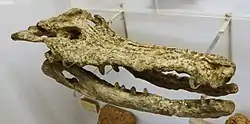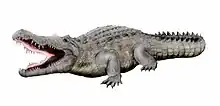| Megadontosuchus | |
|---|---|
 | |
| Scientific classification | |
| Domain: | Eukaryota |
| Kingdom: | Animalia |
| Phylum: | Chordata |
| Class: | Reptilia |
| Clade: | Archosauromorpha |
| Clade: | Archosauriformes |
| Order: | Crocodilia |
| Superfamily: | Gavialoidea |
| Genus: | †Megadontosuchus Mook, 1955 |
| Species | |
| |
| Synonyms | |
| |
Megadontosuchus is an extinct monospecific genus of gavialoid crocodylian,[1] traditionally regarded as a member of Tomistominae, from the middle Eocene of Italy. Fossils have been found from Monte Duello in the province of Verona. The genus is currently monotypic, with the type and only species being Megadontosuchus arduini. The species was originally named in 1880, although it was assigned to the genus Crocodilius (now spelled Crocodylus). The genus was first erected by paleontologist Charles C. Mook in 1955 along with the genus Kentisuchus, which was also first classified as Crocodilius. No holotype for Megadontosuchus was designated in 1880, and a lectotype wasn't proposed until 2007.[2]

Megadontosuchus differs from other traditional "tomistomines" in that it has a more robust rostrum, very large teeth (hence the generic name meaning big-toothed crocodile), and large supratemporal fenestrae on the skull table.[2]
References
- ↑ Iijima, M.; Kobayashi, Y. (2019). "Mosaic nature in the skeleton of East Asian crocodylians fills the morphological gap between "Tomistominae" and Gavialinae". Cladistics. 35 (6): 623–632. doi:10.1111/cla.12372. PMID 34618925. S2CID 91400957.
- 1 2 Piras, P.; Delfino, M.; Favero, L.D.; Kotsakis, T. (2007). "Phylogenetic position of the crocodylian Megadontosuchus arduini and tomistomine palaeobiogeography" (PDF). Acta Palaeontologica Polonica. 52 (2): 315–328. Archived from the original (PDF) on 2011-06-13. Retrieved 2010-08-22.


